Universal cinema lenses for any video camera.
Whether you need to assemble a personal lens kit or compile the equipment-rental list to shoot your next movie, it is very important to find appropriate cinema lenses. As a rule, people follow their own preferences and take into account focal length, build quality, particular look, etc.
The article below describes the best cinema lenses suitable for a documentary style of shooting.
Cinema lenses are becoming more and more popular these days since they are used in the rapidly developing sphere called filmmaking. By using them, video shooters try to improve the quality of their footage.
A high-quality cine lens helps achieve pro-level results because it provides greater control and precision, offers seamless shooting experience and guarantees excellent video performance.
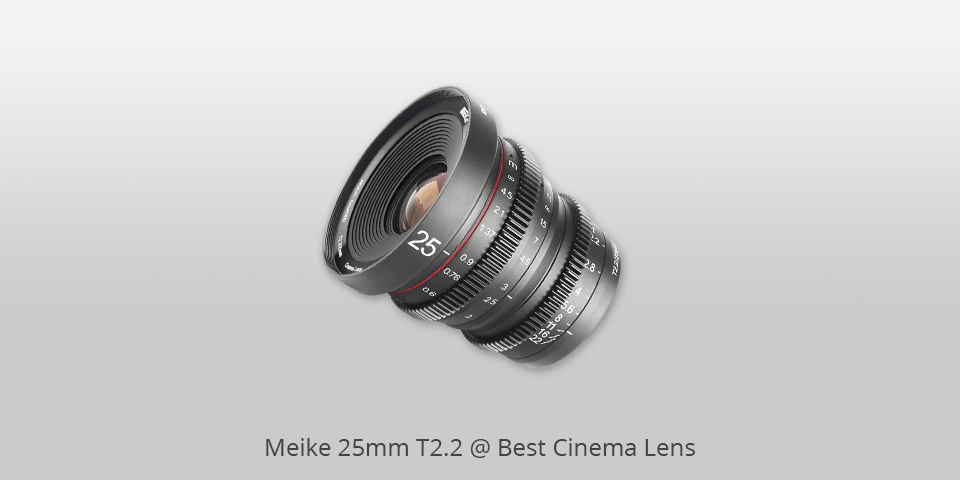
Mount: MFT, Olympus, Panasonic, Lumix, BMPCC | Diaphragm blades: N/A | Autofocus: No | Min focus distance: 0.25 m | Focus rotation: 200° | Filter thread: 77 mm | Length: 90.4 mm | Weight: 557 g
⊕ Professional design
⊕ Precise focus control
⊕ All metal focus
⊕ Solid build
⊖ Chromatic aberration
The Meike 25mm T2.2 provides a maximum aperture that allows working in poor lighting conditions. Moreover, it guarantees increased control over depth of field. Thanks to the multilayer coating, you can also reduce flare and ghosting to achieve greater contrast and color accuracy. The manual focus of this cine lens allows you to work with subjects as close as 9.8 inches away. Smooth and frosted metal lens barrel accounts for better temperature control.

Mount: Canon EF | Diaphragm blades: 11 | Autofocus: No | Min focus distance: 0.46 m | Focus rotation: 200° | Filter thread: 114 mm | Length: 122 mm | Weight: 1160 g
⊕ Aluminum design
⊕ Long focus throw
⊕ Full frame coverage
⊕ Excellent color reproduction
⊖ Rather heavy
⊖ Costly
The Rokinon Xeen XN50-C has a solid aluminum body with smooth and accurate focusing and aperture gears. This cinematic lens has a diameter of 114 mm. If you have a full-frame camera, you will get a normal angle of view. If your camera is of a smaller format, you will have a tighter angle of view. The XN50-C offers dual-sided focus scales in feet, with dual-sided iris scales. Thanks to the 11-bladed iris, you will achieve a rounded aperture and create natural-looking highlights and a bokeh effect.
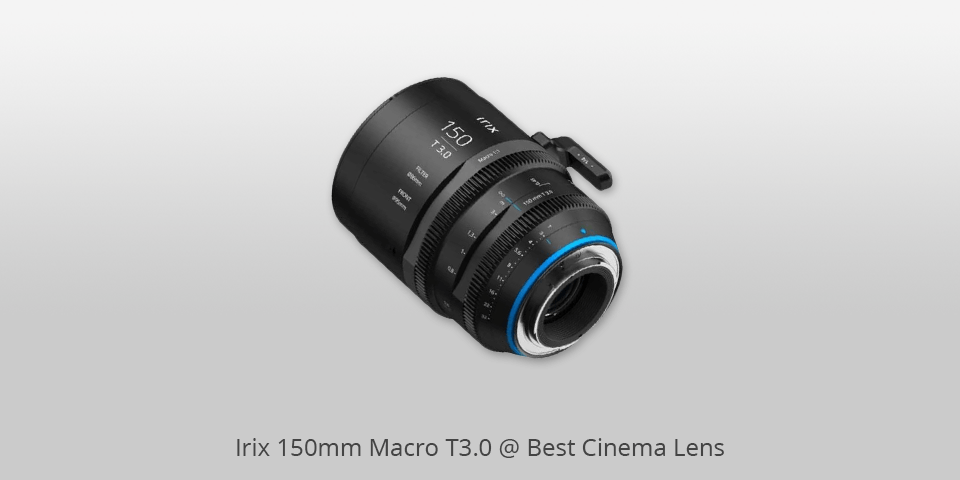
Mount: Canon EF, Sony E, Arri PL, MFT | Diaphragm blades: 11 | Autofocus: No | Min focus distance: 0.35 m | Focus rotation: 270° | Filter thread: 86 mm | Length: 136 mm | Weight: 1105 g
⊕ MST lens positioning system
⊕ Sealed body
⊕ Easy and accurate focusing
⊕ Detachable support foot
⊕ Removable and reversible lens hood
⊖ Poor image stabilization
⊖ For mirrorless cameras only
Thanks to the new MST lens positioning system (created specifically for the Irix Cine line), the Irix 150mm Macro provides a quiet and smooth rotation of the focus ring.
The Multi Start Thread mechanism and sealed body guarantee durable and long-term performance in various weather conditions. There are several seals to protect the optics from dust, rain and splashes of water.
Easy and accurate focusing at any range is achieved thanks to the rotation angle of the focus ring (270 degrees). Moreover, this cine lens has a unique Magnetic Mount System for accessories. MMS system offers easy attachment of necessary gear.
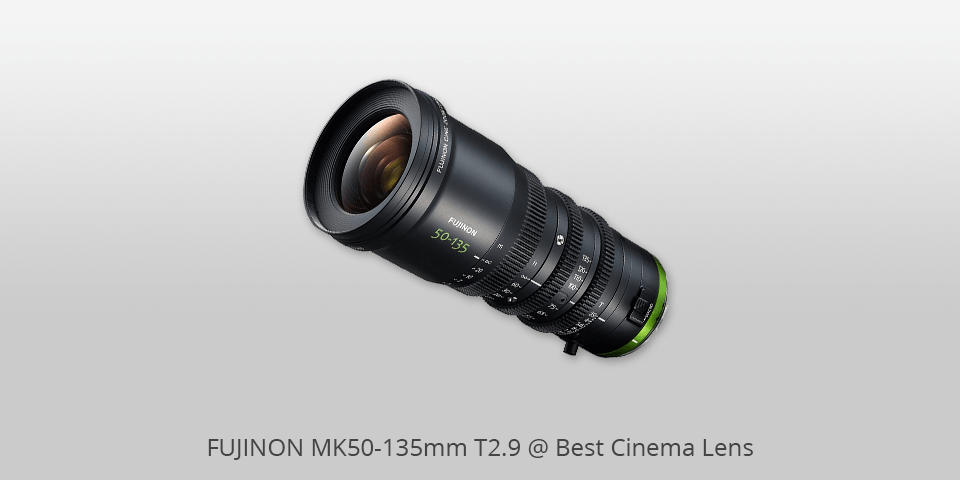
Mount: Sony E, Fujifilm X, MFT | Diaphragm blades: 9 | Autofocus: No | Min focus distance: 1.2 m | Focus rotation: 200° | Filter thread: 82 mm | Length: 206.3 mm | Weight: 980 g
⊕ Lightweight construction
⊕ Great optical performer
⊕ All-internal zoom and focus
⊕ Completely manual operation
⊕ Excellent image performance
⊖ Lacks mounting options
⊖ Not compatible with full-frame cameras
The MK cinema lenses are very similar to Fujifilm’s Cabrio line of optics, but they are more affordable. They have the same coatings and identical mechanical build.
This cine lens provides high optical performance and low distortion with T2.9 speed across the entire zoom range.
Thanks to the compatibility of the Super 35 mm sensor with a dedicated E-mount design, the MK50-135mm is quite convenient to use. Besides, it’s pretty lightweight.
Although the lens barrel is plastic, the housing is very sturdy and reliable.
The MK50-135mm is equipped with three fully manual lens rings for focus, zoom and iris with 0.8M gear pitch and a 200° focus rotation angle for excellent operability.
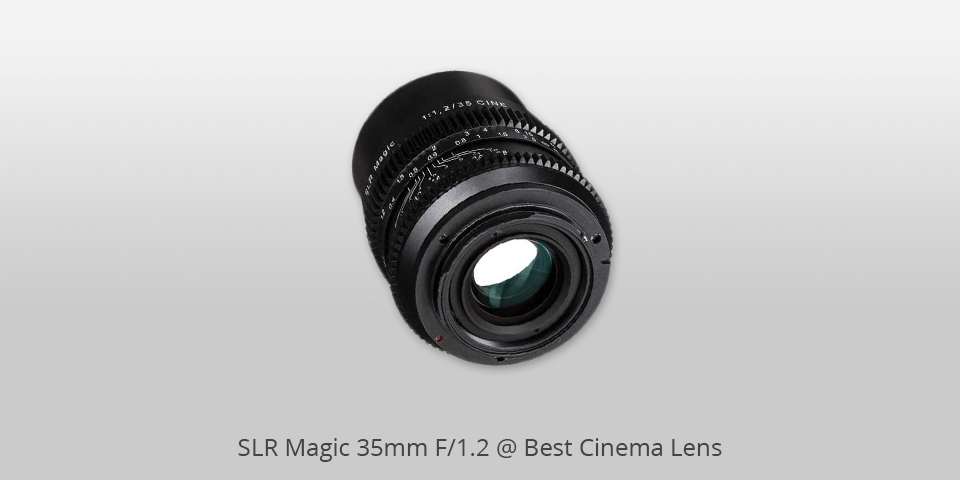
Mount: Sony E | Diaphragm blades: 13 | Autofocus: No | Min focus distance: 0.3 m | Focus rotation: N/A | Filter thread: 52 mm | Length: 70 mm | Weight: 470 g
⊕ Built-in iris and focus gears
⊕ Clickless iris ring
⊕ Covers full-frame sensors
⊕Budget price
⊖ Build quality
⊖ Focus shift
When used with Sony E-Mount cameras, the SLR Magic 35mm f/1.2 provides high-quality cine-style shooting.
This is a wide-angle lens for full-frame sensors; so, if you have an APS-C sensor, the equivalent focal length will be that of a nifty-fifty 50mm lens.
These optics may be used for portrait, interiors, architectural, landscape cinematography and photography.
Thanks to the clickless iris, you can adjust the exposure during the shot.
When you focus this cinematic lens, the front of it doesn’t rotate, so you can easily use additional polarizing filters and accessories.
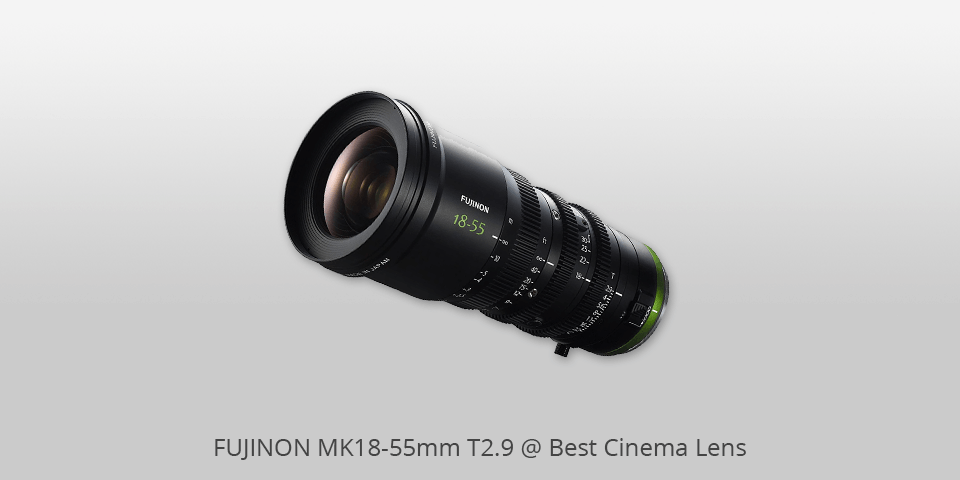
Mount: Sony E, Fujifilm X, MFT | Diaphragm blades: 9 | Autofocus: No | Min focus distance: 0.85 m | Focus rotation: 200° | Filter thread: 82 mm | Length: 206.3 mm | Weight: 980 g
⊕ Impressive build quality
⊕ Compact design
⊕ Great optical performance
⊕ Seamless iris
⊕ Full manual mechanisms
⊖ Not compatible with full-frame cameras
⊖ Lacks mount options
Thanks to Super 35mm / APS-C sensor compatibility and E-mount dedicated design, this lens is very compact and lightweight. It weighs less than 1 kg, reduces lens breathing, suppresses focus shift and optical axis shift while zooming.
The focus system of this lens was designed to satisfy the requirements of cinematographers. It offers 200 degrees of focus rotation and allows for precise focus adjustments.
Vibrations and noise caused by the clicking mechanism are reduced thanks to the seamless iris.
This cine lens is identical in weight, dimensions, front diameter and filter size with an the MK 50-135mm one, so you can easily switch between these options.
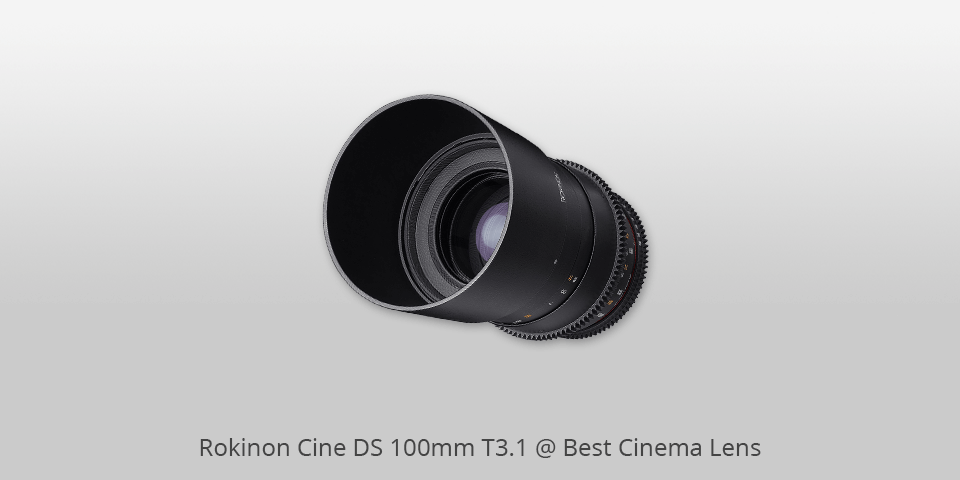
Mount: Canon EF | Diaphragm blades: 9 | Autofocus: No | Min focus distance: 0.3 m | Focus rotation: N/A | Filter thread: 67 mm | Length: 123.1 mm | Weight: 725 g
⊕ Great build quality
⊕ High-quality close-up shots
⊕ Compatible with all full-frame Canons
⊕ Detachable lens hood
⊕ Unified aperture gears
⊖ Omits optical image stabilization
⊖ Edge softness at wide apertures
The Cine DS 100mm T3.1 lens provides clear and sharp video quality, tight color matching and exact focusing. Thanks to these features, it is one of the best cinema lenses for professional filmmakers.
It utilizes a multi-layer coating process for consistent color rendition from lens to lens. The DS 100mm offers an industry-standard geared focus and iris rings that have the same position as other Rokinon Cine DS lenses.
Using this lens, you can take extreme close-up images of small objects where the size of the object on the image sensor seems to be life-size or greater.
If you shoot without a matte box, a detachable lens hood provides flare protection.
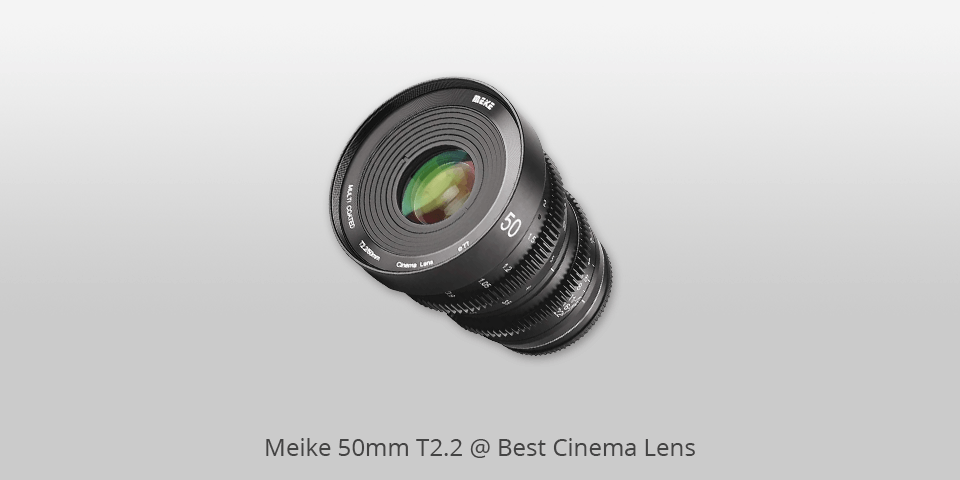
Mount: Sony E, Fujifilm X, MFT | Diaphragm blades: N/A | Autofocus: No | Min focus distance: 0.6 m | Focus rotation: 270° | Filter thread: 77 mm | Length: N/A | Weight: 660 g
⊕ Large aperture
⊕ Extremely long focus
⊕ Multi-layer coating
⊕ Minimal focus breathing
⊖ Soft corners
The Meike 50mm T2.2 cinema lens is a combination of a metal body and low-dispersion glass optics with multilayer coating. Thanks to multiple coatings, glare and ghosting are reduced, which accounts for greater contrast and color accuracy.
The low-light friendly T2.2 maximum aperture is very fast and allows for increased control over depth of field. Scale markings are provided in inches and feet. A focus rotation of 270 degrees allows you to manually adjust the focus.
| Image | Name | Features | |
|---|---|---|---|
 |
Meike 25mm T2.2
Our choice |
CHECK PRICE → | |
 |
Rokinon Xeen XN50-C 50mm T1.5
EF Mount |
CHECK PRICE → | |
 |
Irix 150mm Macro T3.0
Full Frame |
CHECK PRICE → |

Experienced shooters know that the lens contributes greatly to the quality of your photo or video. Whether you are a beginner or skillful professional, it is very important to understand what kind of lens you need. Read on and you will know what particular parameters you should pay attention to while choosing cinema lenses.
When choosing between different cinema lenses, pay attention to the mount type first.
As a rule, manufacturers create lenses with mounts that fit only their cameras; sometimes a lens has several mounts to fit different camera lines by the same manufacturer.
So, before buying a cine lens, clearly define what mount your camera uses. For example, lens mounts for DSLRs include the Nikon F-mount, Canon’s EF or EF-S, the Pentax K and Sony’s Alpha (A) mount. The Canon EF-M, Fujifilm XF, Nikon 1, Sony E, Samsung NX and Pentax Q mounts fit mirrorless interchangeable lens cameras.
Before getting a new cine lens, you should consider its focal length. It is measured in millimeters, and it is the first number denoted in a lens description. The lower the number, the wider the angle of view; consequently, such lenses capture more of the scene. If a lens has a longer focal length, it brings the viewer closer to the action with more space compression in the image.
If you choose very wide lenses, an image might be distorted. The most suitable lenses for filmmaking are those with focal lengths ranging between 20mm and 100mm, while 50mm lenses approximate the field of view of the human eye.
One more thing that should be considered while choosing the best cinema lenses is the sensor format of your camera. Here, I consider various sensors, from largest to smallest; they are full-frame ones, like APS-C and Super35, and Micro Four Thirds. MFT stands for a sensor and a mount type. The image from a full-frame lens will cover a smaller sensor since full-frame sensors are the largest.

The maximum aperture denotes how much light the lens can get through to the sensor. This parameter is stated on all lenses. Much light means that an image will not be blurred even in poor lighting conditions. Aperture is characterized by a number, like f/2.8 (or sometimes 1:2.8). The smaller the aperture, the more light can enter the camera. In theory, the best aperture you can have is an objective equal to 1. In reality, the brightest lens provides a maximum aperture of around f/1.2. For the majority of users, an aperture number of between f/2.4 and f/3.2 is quite enough. In general, the lower the aperture number, the more expensive the lens is.
If you need lenses for cinematography, it is recommended to choose specific lenses offering smooth transitions between different focal distances. For the record, photo lenses usually have “jumpy” zoom rings that are not suitable for video shooting.
Although these optics are not considered to be the best cinema lenses on paper, a 28mm lens has been a gold standard in shooting motion pictures for over a hundred years. It was used to capture the most famous moments in filmmaking history.
The thing is that cinema lenses are better built and optimized for film shooting, consequently, they are more expensive. However, many people use photo lenses for video purposes and get satisfactory results for less money. It is just the right optics for shooting videos, and if you can afford it, buy it without thinking.
Lenses for filmmaking have a slight optical advantage over photography ones. They have such mechanical advantages as no breathing, color matching, no vignetting, long-focus throws, well laid out witness marks, t-stops. These options mean a lot for moving images, but they aren’t useful for photos.